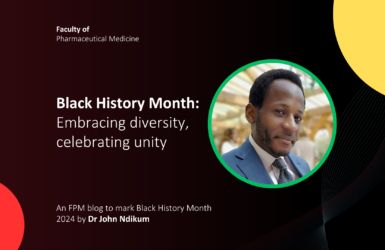I Have A Dream: My Diversity Ambitions for Society
Posted on: Monday 7 October 2024
Author: Dr Leonard Weather Jr FFPM


As a Black physician, clinical researcher, and advocate for diversity in medicine, I’ve had the privilege of witnessing significant progress in our society’s approach to diversity and inclusion. However, I’ve also seen firsthand the challenges and disparities that persist. Respectfully, I’d like to share my vision and my dream for a truly diverse and inclusive society, drawing inspiration from Dr. Martin Luther King Jr.’s iconic speech and applying it to the present time [1].
A Society of Equal Opportunity
I dream of a society where opportunity is truly equal, not just in theory, but in practice. In this society, a child’s race, gender, socioeconomic background, or zip code should not determine their access to quality education, healthcare, or career prospects. As a gynaecologist who has written extensively on endometriosis and other female disorders, I envision a world where all women, regardless of their background, have equal access to comprehensive healthcare and the latest medical advancements.
This dream extends beyond just access. It’s about creating environments where everyone feels valued, respected, and empowered to reach their full potential. In the medical field, this means fostering a culture where diverse perspectives are not just tolerated but actively sought out and integrated into decision-making processes.
Diversity in Leadership
My vision includes a dramatic shift in the composition of leadership across all sectors of society. I dream of boardrooms, C-suites, and government offices that truly reflect the diversity of our population. As Past President of the National Medical Association (the world’s oldest and largest Black Medical Organisation, founded in 1895), President of the Academy of Physicians in Clinical Research and past and current president of numerous local, state, and national professional organisations, I’ve seen the positive impact of diverse leadership firsthand.
In this dream, it’s not unusual to see people of colour, women, and individuals from other underrepresented groups in positions of power and influence. This diversity at the top cascades down, creating role models and opening doors for future generations [2]. It’s a world where a young Black girl can look at leaders in medicine, business, or politics and see herself represented, nurturing her ambitions and broadening her horizons.
“Let us work tirelessly to increase diversity in our institutions, to advocate for policies that promote equity, and to create inclusive environments in our spheres of influence. Let us challenge our own biases and those of others. Let us celebrate our differences while recognising our common humanity.”
Inclusive Education and Curriculum
Education plays a pivotal role in my vision for a diverse society. I dream of an education system that provides equal opportunities and celebrates and incorporates diverse perspectives in its curriculum. History lessons that comprehensively cover the contributions of all communities, literature that spans a wide range of cultural experiences, and science courses that highlight the achievements of diverse researchers and innovators.
In medical education, this means integrating cultural competency throughout the curriculum, ensuring that future healthcare professionals are equipped to serve diverse populations effectively [3]. It also involves actively working to increase diversity in medical school admissions, creating a physician workforce that better reflects the communities they serve.
Equitable Healthcare
As a physician and clinical researcher, a cornerstone of my dream is a healthcare system free from racial disparities. I envision a society where all individuals, regardless of race or ethnicity, receive the same high standard of care. This includes equal access to preventive services, cutting-edge treatments, and participation in clinical trials.
In this dream, we’ve eliminated the grim health disparities that currently exist. Maternal mortality rates for Black women are no longer disproportionately high [4]. Chronic diseases don’t disproportionately affect communities of colour. And when new medical breakthroughs occur, they benefit all segments of society equally.

Workplace Diversity and Inclusion
My dream extends to the workplace, where diversity is not just about meeting quotas, but about creating genuinely inclusive environments. I envision workplaces where diverse teams are the norm, leading to enhanced creativity, innovation, and problem-solving. In these workplaces, employees from all backgrounds feel comfortable bringing their whole selves to work, and their unique perspectives are valued and leveraged [5].
In the medical field, this translates to diverse healthcare teams that can better understand and address the needs of a diverse patient population. It means research teams that bring varied perspectives to clinical trials, ensuring that medical advancements benefit all communities.
Celebration of Cultural Diversity
In my dream, diversity is not just accepted but celebrated. I see a society that recognises the strength that comes from our differences, a true cultural mosaic where each piece retains its unique characteristics while contributing to a beautiful whole. This celebration of diversity is reflected in our arts, media, and public discourse.
Cultural competency becomes second nature, with individuals actively seeking to understand and appreciate cultures different from their own. This leads to a society with less bias, discrimination, and hate, replaced by curiosity, respect, and mutual understanding.
Continuous Growth and Self-Reflection
My dream is not of a static utopia but of a society committed to continuous growth and self-reflection. I see a world where individuals and institutions alike are willing to confront their biases, learn from their mistakes, and constantly strive to be more inclusive.
This involves creating safe spaces for difficult conversations about race, privilege, and equity. It means fostering a culture of accountability, where discriminatory actions are addressed promptly and fairly and where efforts towards inclusion are recognised and rewarded.

Conclusion: A Call to Action
This dream – of a truly diverse, equitable, and inclusive society – may seem ambitious. But as Dr. King showed us, colossal dreams have the power to inspire real change. Achieving this vision requires commitment and action from all of us. As healthcare professionals, researchers, educators, and leaders, we have a unique role to play in bringing this dream to fruition.
Let us work tirelessly to increase diversity in our institutions, to advocate for policies that promote equity, and to create inclusive environments in our spheres of influence. Let us challenge our own biases and those of others. Let us celebrate our differences while recognising our common humanity.
For in the end, this dream of diversity and inclusion is not just about fairness or representation–it’s about creating a society that is richer, more innovative, more compassionate, and ultimately, more capable of solving the complex challenges we face. “Yes,” I have a dream that is worth striving for, and a future worth building, together.
About Dr Leonard Weather Jr. FFPM
Leonard Weather Jr., RPh, MD, FAPC was awarded Fellowship of FPM in 2024 and is currently a gynecologist. He received his BS in Pharmacy from Howard University and his MD from Rush Medical College in Chicago, IL. He completed his internship, residency and fellowship in gynecology and obstetrics at the Johns Hopkins University Hospital, Baltimore, MD. Dr Weather is a health educator and professor, ordained minister, artist, author, and photographer. He has authored three inspirational poetry books, an infertility handbook and his most recent book, (June 2023), is “Endometriosis, the Name of the Pain and How to Repress It.” He is an active gynecological clinical trials researcher, has presented over 210 peer review presentations and papers on pelviscopic surgical treatment of infertility, endometriosis, pelvic pain and fibroids. He invented the surgical procedure Optical Dissection Pelviscopy, to assist in the prevention of organ injury during laparoscopy. Dr Weather is Past President of the National Medical Association, New Orleans Medical Association, and the Louisiana Medical Association. He currently serves as the President of the North Louisiana Medical Association. Additionally, he is a member of the Board of Scientific Advisors to the Endometriosis Association, a Fellow of the Federation of State Medical Boards, a Fellow of the Academy of Physicians in Clinical Research, National President of the Chi Delta Mu Medical Fraternity, Board Member of the Louisiana State Board of Examiners, and a Board Member of the Academy of Physicians in Clinical Research (APCR), Board of Trustees. October 6, 2023, he was elected APCR President. Additionally, December 2023, he was appointed American Medical Association’s Representative to the United States Adopted Name Review Board. (The US Adopted Names (USAN) Council is responsible for selecting informative and unique nonproprietary (generic) drug names. Instances where nomenclature disputes between the USAN Council and applicants cannot be resolved and normal procedures fail, the USAN Review Board is the final arbiter.

